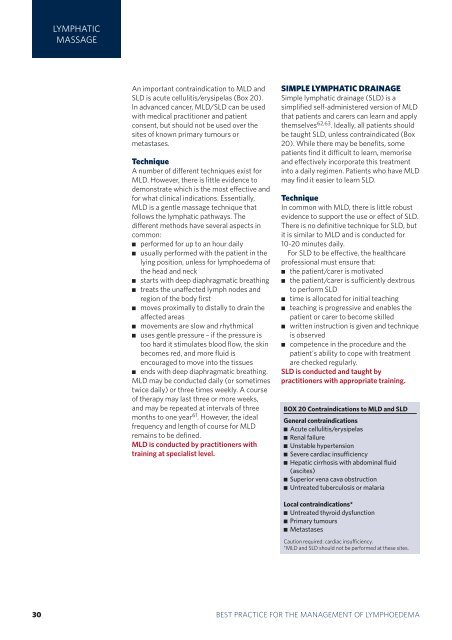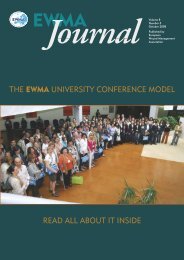best practice for the management of lymphoedema ... - EWMA
best practice for the management of lymphoedema ... - EWMA
best practice for the management of lymphoedema ... - EWMA
Create successful ePaper yourself
Turn your PDF publications into a flip-book with our unique Google optimized e-Paper software.
LYMPHATIC<br />
MASSAGE<br />
An important contraindication to MLD and<br />
SLD is acute cellulitis/erysipelas (Box 20).<br />
In advanced cancer, MLD/SLD can be used<br />
with medical practitioner and patient<br />
consent, but should not be used over <strong>the</strong><br />
sites <strong>of</strong> known primary tumours or<br />
metastases.<br />
Technique<br />
A number <strong>of</strong> different techniques exist <strong>for</strong><br />
MLD. However, <strong>the</strong>re is little evidence to<br />
demonstrate which is <strong>the</strong> most effective and<br />
<strong>for</strong> what clinical indications. Essentially,<br />
MLD is a gentle massage technique that<br />
follows <strong>the</strong> lymphatic pathways. The<br />
different methods have several aspects in<br />
common:<br />
■ per<strong>for</strong>med <strong>for</strong> up to an hour daily<br />
■ usually per<strong>for</strong>med with <strong>the</strong> patient in <strong>the</strong><br />
lying position, unless <strong>for</strong> <strong>lymphoedema</strong> <strong>of</strong><br />
<strong>the</strong> head and neck<br />
■ starts with deep diaphragmatic breathing<br />
■ treats <strong>the</strong> unaffected lymph nodes and<br />
region <strong>of</strong> <strong>the</strong> body first<br />
■ moves proximally to distally to drain <strong>the</strong><br />
affected areas<br />
■ movements are slow and rhythmical<br />
■ uses gentle pressure – if <strong>the</strong> pressure is<br />
too hard it stimulates blood flow, <strong>the</strong> skin<br />
becomes red, and more fluid is<br />
encouraged to move into <strong>the</strong> tissues<br />
■ ends with deep diaphragmatic breathing.<br />
MLD may be conducted daily (or sometimes<br />
twice daily) or three times weekly. A course<br />
<strong>of</strong> <strong>the</strong>rapy may last three or more weeks,<br />
and may be repeated at intervals <strong>of</strong> three<br />
months to one year 61 . However, <strong>the</strong> ideal<br />
frequency and length <strong>of</strong> course <strong>for</strong> MLD<br />
remains to be defined.<br />
MLD is conducted by practitioners with<br />
training at specialist level.<br />
SIMPLE LYMPHATIC DRAINAGE<br />
Simple lymphatic drainage (SLD) is a<br />
simplified self-administered version <strong>of</strong> MLD<br />
that patients and carers can learn and apply<br />
<strong>the</strong>mselves 62,63 . Ideally, all patients should<br />
be taught SLD, unless contraindicated (Box<br />
20). While <strong>the</strong>re may be benefits, some<br />
patients find it difficult to learn, memorise<br />
and effectively incorporate this treatment<br />
into a daily regimen. Patients who have MLD<br />
may find it easier to learn SLD.<br />
Technique<br />
In common with MLD, <strong>the</strong>re is little robust<br />
evidence to support <strong>the</strong> use or effect <strong>of</strong> SLD.<br />
There is no definitive technique <strong>for</strong> SLD, but<br />
it is similar to MLD and is conducted <strong>for</strong><br />
10-20 minutes daily.<br />
For SLD to be effective, <strong>the</strong> healthcare<br />
pr<strong>of</strong>essional must ensure that:<br />
■ <strong>the</strong> patient/carer is motivated<br />
■ <strong>the</strong> patient/carer is sufficiently dextrous<br />
to per<strong>for</strong>m SLD<br />
■ time is allocated <strong>for</strong> initial teaching<br />
■ teaching is progressive and enables <strong>the</strong><br />
patient or carer to become skilled<br />
■ written instruction is given and technique<br />
is observed<br />
■ competence in <strong>the</strong> procedure and <strong>the</strong><br />
patient's ability to cope with treatment<br />
are checked regularly.<br />
SLD is conducted and taught by<br />
practitioners with appropriate training.<br />
BOX 20 Contraindications to MLD and SLD<br />
General contraindications<br />
■ Acute cellulitis/erysipelas<br />
■ Renal failure<br />
■ Unstable hypertension<br />
■ Severe cardiac insufficiency<br />
■ Hepatic cirrhosis with abdominal fluid<br />
(ascites)<br />
■ Superior vena cava obstruction<br />
■ Untreated tuberculosis or malaria<br />
Local contraindications*<br />
■ Untreated thyroid dysfunction<br />
■ Primary tumours<br />
■ Metastases<br />
Caution required: cardiac insufficiency.<br />
*MLD and SLD should not be per<strong>for</strong>med at <strong>the</strong>se sites.<br />
30 BEST PRACTICE FOR THE MANAGEMENT OF LYMPHOEDEMA

















